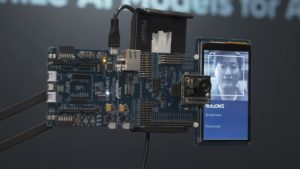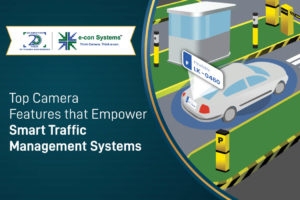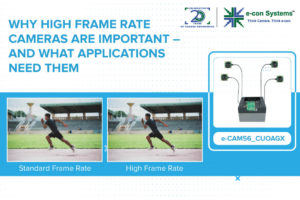Cameras and Sensors for Embedded Vision
WHILE ANALOG CAMERAS ARE STILL USED IN MANY VISION SYSTEMS, THIS SECTION FOCUSES ON DIGITAL IMAGE SENSORS
While analog cameras are still used in many vision systems, this section focuses on digital image sensors—usually either a CCD or CMOS sensor array that operates with visible light. However, this definition shouldn’t constrain the technology analysis, since many vision systems can also sense other types of energy (IR, sonar, etc.).
The camera housing has become the entire chassis for a vision system, leading to the emergence of “smart cameras” with all of the electronics integrated. By most definitions, a smart camera supports computer vision, since the camera is capable of extracting application-specific information. However, as both wired and wireless networks get faster and cheaper, there still may be reasons to transmit pixel data to a central location for storage or extra processing.
A classic example is cloud computing using the camera on a smartphone. The smartphone could be considered a “smart camera” as well, but sending data to a cloud-based computer may reduce the processing performance required on the mobile device, lowering cost, power, weight, etc. For a dedicated smart camera, some vendors have created chips that integrate all of the required features.
Cameras
Until recent times, many people would imagine a camera for computer vision as the outdoor security camera shown in this picture. There are countless vendors supplying these products, and many more supplying indoor cameras for industrial applications. Don’t forget about simple USB cameras for PCs. And don’t overlook the billion or so cameras embedded in the mobile phones of the world. These cameras’ speed and quality have risen dramatically—supporting 10+ mega-pixel sensors with sophisticated image processing hardware.
Consider, too, another important factor for cameras—the rapid adoption of 3D imaging using stereo optics, time-of-flight and structured light technologies. Trendsetting cell phones now even offer this technology, as do latest-generation game consoles. Look again at the picture of the outdoor camera and consider how much change is about to happen to computer vision markets as new camera technologies becomes pervasive.
Sensors
Charge-coupled device (CCD) sensors have some advantages over CMOS image sensors, mainly because the electronic shutter of CCDs traditionally offers better image quality with higher dynamic range and resolution. However, CMOS sensors now account for more 90% of the market, heavily influenced by camera phones and driven by the technology’s lower cost, better integration and speed.

Nota AI Demonstration of Revolutionizing Driver Monitoring Systems
Tae-Ho Kim, CTO and Co-founder of Nota AI, demonstrates the company’s latest edge AI and vision technologies and products at the 2024 Embedded Vision Summit. Specifically, Kim demonstrates Nota DMS, his company’s state-of-the-art driver monitoring system. The solution enhances driver safety by monitoring attention and detecting drowsiness in real-time. Cutting-edge AI techniques make Nota DMS

Steering a Revolution: Optimized Automated Driving with Heterogeneous Compute
This blog post was originally published at Qualcomm’s website. It is reprinted here with the permission of Qualcomm Qualcomm Technologies’ latest whitepaper navigates the advantages of Snapdragon Ride Solutions based on heterogeneous compute SoCs. As the automotive industry continues to progress toward automated driving, advanced driver assistance systems (ADAS) are in high demand. These systems

Top Camera Features that Empower Smart Traffic Management Systems
This blog post was originally published at e-con Systems’ website. It is reprinted here with the permission of e-con Systems. Traffic systems leverage camera solutions to empower smart cities to handle major traffic challenges. Some of their capabilities include real-time monitoring, incident detection, and law enforcement. Discover the camera’s role in these systems and the

Lattice Semiconductor Demonstration of a Low-latency Edge AI Sensor Bridge for NVIDIA’s Holoscan
Kambiz Khalilian, Director of Strategic Initiatives and Ecosystem Alliances for Lattice Semiconductor, demonstrates the company’s latest edge AI and vision technologies and products at the 2024 Embedded Vision Summit. Specifically, Khalilian demonstrates a low-latency edge AI sensor bridge solution for NVIDIA’s Holoscan. The Lattice FPGA-based Holoscan Sensor Bridge enables high-throughput and low-latency sensor aggregation and

Lumotive Demonstration of a Sensor Hub for LiDAR, Radar and Camera Fusion
Kevin Camera, Vice President of Product for Lumotive, demonstrates the company’s latest edge AI and vision technologies and products in Lattice Semiconductor’s booth at the 2024 Embedded Vision Summit. Specifically, Camera demonstrates a sensor hub for concurrently fusing together and processing data from multiple sources: Velodyne’s VLP-16 LiDAR, Lumotive’s M30 solid state LiDAR, Texas Instruments’

e-con Systems Demonstration of Its Advanced Camera Solutions
Gomathi Sankar Paramasivan, Head of the Industrial Camera Business Unit at e-con Systems, demonstrates the company’s latest edge AI and vision technologies and products in Lattice Semiconductor’s booth at the 2024 Embedded Vision Summit. Specifically, Paramasivan demonstrates his company’s CAM85_CUOAGX and See3CAM50_CUG advanced camera solutions based on Lattice Semiconductor FPGAS. The showcased cameras are powered

Strategic Partnership Between FRAMOS and Antmicro Enables Rapid Development of Open Source-based Embedded Vision Systems
July 17, 2024 – For more than 40 years, FRAMOS has been helping customers around the world develop groundbreaking image processing systems that enable breakthroughs in a wide range of industries. In all phases of the development and deployment of image processing systems, companies rely on FRAMOS’ proven expertise in the areas of component selection,

Why High Frame Rate Cameras are Important, and What Applications Need Them
This blog post was originally published at e-con Systems’ website. It is reprinted here with the permission of e-con Systems. As embedded vision systems keep taking quantum leaps to become more innovative and intuitive, it’s becoming more complex to address the specifications for resolution and frame rate. As you may know, conventionally, applications used in

Cadence Demonstration of Time-of-Flight Decoding on the Tensilica Vision Q7 DSP
Amol Borkar, Director of Product Marketing for Cadence Tensilica DSPs and Automotive Segment Director, demonstrates the company’s latest edge AI and vision technologies and products at the 2024 Embedded Vision Summit. Specifically, Borkar demonstrates the use of a Tensilica Vision Q7 DSP for Time-of-Flight (ToF) decoding. In this demonstration, the Tensilica Vision Q7 DSP integrated

Cadence Demonstration of an Imaging Radar Applications on the Tensilica ConnX B10 DSP
Amol Borkar, Director of Product Marketing for Cadence Tensilica DSPs and Automotive Segment Director, demonstrates the company’s latest edge AI and vision technologies and products at the 2024 Embedded Vision Summit. Specifically, Borkar demonstrates the use of a Tensilica ConnX B10 DSP for automotive imaging radar applications. The ConnX B10 DSP is a highly efficient,

